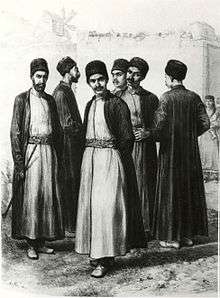Crimean Karaites
|
Karaite men in traditional garb, Crimea, 19th century. | |
| Total population | |
|---|---|
| ≈2,000 | |
| 1,196[1] | |
| | 715[2] |
| 346[3] | |
| 241[4] | |
| 205[5] | |
| Languages | |
| Karaim, Lithuanian, Polish, Russian | |
| Religion | |
| Karaite Judaism, Christianity | |
| Related ethnic groups | |
| Turkic peoples | |
The Crimean Karaites or Krymkaraylar (Crimean Karaim: Кърымкъарайлар sg. къарай – qaray; Trakai Karaim: sg. karaj, pl. karajlar, Hebrew: קראי מזרח אירופה, Turkish: Karaylar), also known as Karaims and Qarays, are an ethnic group derived from Turkic-speaking adherents of Karaism in Central and Eastern Europe, especially in the territory of the former Russian Empire. "Karaim" is a Russian, Ukrainian, Lithuanian, and Polish name for the community.
Origins
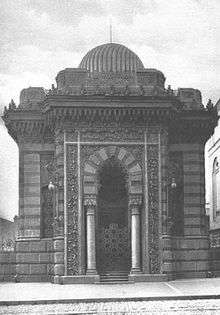
Turkic-speaking Karaites (in the Crimean Tatar language, Qaraylar) have lived in Crimea for centuries. Their origin is a matter of great controversy. Some regard them as descendants of Karaite Jews who settled in Crimea and adopted a form of the Kypchak tongue (see Karaim language). Others view them as descendants of Khazar or Cuman, Kipchak converts to Karaite Judaism. Today many Karaim deny ethnic Semitic origins and identify as descendants of the Khazars.[6] Some specialists in Khazar history question the Khazar theory of Karaim origins.[7][8] They regard the Crimean Karaites as descendants of Karaite Jews who settled in Crimea and adopted a form of the Kypchak tongue (see Karaim language). To support this, they note the following:
- the Karaim language belongs to the Kipchak linguistic group, and the Khazar language belongs to the Bulgar group; there is no close relationship between these two Turkic languages;[9]
- According to the Khazar Correspondence, Khazar Judaism was, most likely, Talmudic.[10] The tradition of Karaite Judaism ranks only the Tanakh as a holy book and does not recognize the Talmud; and
- Khazars disappeared in the 11th century. But, the first written mention of the Crimean Karaites was in the 14th century.[11]
Some modern Karaim resist being identified as Jews, emphasizing their Turkic heritage and claiming they are Turkic practitioners of a "Mosaic religion" separate and distinct from Judaism. Miller says that Crimean Karaites did not start claiming a distinct identity apart from the Jewish people before the 19th century, and that such leaders as Avraham Firkovich and Sima Babovich encouraged this position to avoid the strong anti-Semitism of the period.[12]
From the time of the Golden Horde onward, Karaites were present in many towns and villages throughout Crimea and around the Black Sea. During the period of the Crimean Khanate, they had major communities in the towns of Çufut Qale, Sudak, Kefe, and Bakhchisaray.
History
Middle Ages
According to most opinions, the upper stratum of the Khazar society converted to Judaism in the 8th–9th centuries CE. The extent of this conversion and its scope is not known. With the collapse of the Khazar Khanate, a group of the Khazars who took part in a failed rebellion, joined the Magyars in the invasion of Hungary; they settled there at the end of the 9th century CE. An archeological relic of this Khazar settlement was discovered in Transylvania (today Romania) in the 20th century. Known as the Alsószentmihály Rovas inscription, it was transcribed by the archaeologist-historian Gábor Vékony.[13] According to the transcription, the two-row inscription means the following:[14]
(first row) "His mansion is famous."
(second row) "Jüedi Kür Karaite." or "Jüedi Kür the Karaite."
Scholars take this as evidence that at least a part of the Khazars were Karaites. (See Inscription in Khazarian Rovas script)
Grand Duchy of Lithuania and Polish–Lithuanian Commonwealth
According to Karaite tradition,[15] Grand Duke Vytautas of the Grand Duchy of Lithuania relocated one branch of the Crimean Karaites to Lithuania. There they continued to speak their own language. But the Lithuanian dialect of the Karaim language differs significantly from the Crimean one.[16] The Lithuanian Karaites settled primarily in Vilnius and Trakai, as well as in Biržai, Pasvalys, Naujamiestis and Upytė – smaller settlements throughout Lithuania proper.
The Lithuanian Karaites also settled in lands of modern Belarus and Ukraine, which were part of the Grand Duchy of Lithuania. The Karaite communities emerged in Halicz and Kokizow (near Lwów) in Galicia, as well as in Łuck and Derazhne in Volhynia.[17][18][19] Jews (Rabbinites and Karaites) in Lithuanian territory were granted a measure of autonomy under Michel Ezofovich Senior's[20] management. The Trakai Karaim refused to comply, citing differences in faith. Later all Jews, including Karaites,[21] were submitted to Rabbinite "Council of Four Lands" (Vaad)[22] and "Council of the Land of Lithuania" taxation (1580–1646). The Yiddish-speaking Rabbinites considered the Turkic-speaking Karaites to be apostates, and kept them in a subordinate and depressed position. The Karaites resented this treatment. In 1646 the Karaites gained expulsion of the Rabbinites from Trakai. Despite such tensions, in 1680 Rabbinite community leaders defended the Karaites of Shaty (near Trakai) against blood accusation. Representatives of both groups signed an agreement in 1714 to respect the mutual privileges and resolve disputes without involving the Gentile administration.
According to Crimean Karaite tradition, which developed in the 20th century inter-war Poland[23] their forefathers were mainly farmers and members of the community who served in the military forces of the Grand Duchy of Lithuania and the Polish–Lithuanian Commonwealth,[24] as well as in the Crimean Khanate. According to the historical documents of the Grand Duchy of Lithuania, the chief occupation of the Crimean Karaites was usury.[25] They were granted special privileges, including exemption from the military service.[26] In the Crimean Khanate, the Karaites were repressed like other Jews, with prohibitions on behavior extended to riding horses.[27]
Some famous Karaim scholars in Lithuania included Isaac b. Abraham of Troki (1543–1598), Joseph ben Mordecai Malinovski, Zera ben Nathan of Trakai, Salomon ben Aharon of Trakai, Ezra ben Nissan (died in 1666) and Josiah ben Judah (died after 1658). Some of the Karaim became quite wealthy.
During the times of the Polish-Lithuanian Commonwealth, the Karaim suffered severely during the Chmielnicki Uprising of 1648 and the wars between Russia and Commonwealth in the years 1654–1667. The many towns plundered and burnt included Derazhne and Trakai, where only 30 families were left in 1680. The destruction of the Karaite community in Derazhne in 1649 is described in a poem (both in Hebrew and Karaim language) by a leader of the congregation, Hazzan Joseph ben Yesh'uah Ha-Mashbir.[28] Catholic missionaries worked to convert the local Karaim to Christianity, but were largely unsuccessful.
Russian Empire
19th-century leaders of the Karaim, such as Sima Babovich and Avraham Firkovich, were driving forces behind a concerted effort to alter the status of the Karaite community in eyes of the Russian legal system. Firkovich in particular was adamant in his attempts to connect the Karaim with the Khazars, and has been accused of forging documents and inscriptions to back up his claims.[29]
Ultimately, the Tsarist government officially recognized the Karaim as being of Turkic, not Jewish, origin. Because the Karaim were judged to be innocent of the death of Jesus, they were exempt from many of the harsh restrictions placed on other Jews. They were, in essence, placed on equal legal footing with Crimean Tatars. The related Krymchak community, which was of similar ethnolinguistic background but which practiced rabbinical Judaism, continued to suffer under Tsarist anti-Jewish laws.
Solomon Krym (b. 1864, d. 1936), a Crimean Karaite agronomist, was elected in 1906 to the First Duma (1906–1907) as a Kadet (National Democratic Party). On November 16, 1918 he became the Prime Minister of a short-lived Crimean Russian liberal, anti-separatist and anti-Soviet government also supported by the German army.[30]
Since the incorporation of Crimea into the Russian Empire the main center of the Qarays is the city of Eupatoria. Their status under Russian imperial rule bore beneficial fruits for the Karaites decades later.
During the Holocaust
In 1934, the heads of the Karaite community in Berlin asked the Nazi authorities to exempt Karaites from the anti-Semitic regulations based on their legal status as Russians in Russia. The Reich Agency for the Investigation of Families determined that from the standpoint of German law, the Karaites were not to be considered Jews. The letter from the Reichsstelle für Sippenforschung (de) officially ruled:
The Karaite sect should not be considered a Jewish religious community within the meaning of paragraph 2, point 2 of the First Regulation to the Reich Citizenship Law. However, it cannot be established that Karaites in their entirety are of blood-related stock, for the racial categorization of an individual cannot be determined without … his personal ancestry and racial biological characteristics— [31]
This ruling set the tone for how the Nazis dealt with the Karaite community in Eastern Europe. At the same time, the Nazis had serious reservations about the Karaites. SS Obergruppenfuhrer Gottlob Berger wrote on November 24, 1944:
"Their Mosaic religion is unwelcome. However, on grounds of race, language and religious dogma... Discrimination against the Karaites is unacceptable, in consideration of their racial kinsmen [Berger was here referring to the Crimean Tatars]. However, so as not to infringe the unified anti-Jewish orientation of the nations led by Germany, it is suggested that this small group be given the opportunity of a separate existence (for example, as a closed construction or labor battalion)..."
Despite having exempt status, groups of Karaites were massacred in the early phases of the war. German soldiers who came across Karaites in Russia during the invasion of Operation Barbarossa, unaware of their legal status under German law, attacked them; 200 were killed at Babi Yar alone. German allies such as Vichy France began to require the Karaites to register as Jews, but eventually granted them non-Jewish status after getting orders by Berlin.[32]
When interrogated, Ashkenazi rabbis in Crimea told the Germans that Karaites were not Jews, in an effort to spare the Karaite community the fate of their Rabbanite neighbors.[33] Many Karaites risked their lives to hide Jews, and in some cases claimed that Jews were members of their community. The Nazis impressed many Karaites into labor battalions.[34]
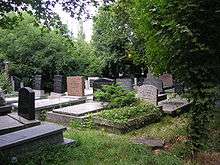
In Vilnius and Trakai, the Nazis forced Karaite Hakham Seraya Shapshal to produce a list of the members of the community. Though he did his best, not every Karaite was saved by Shapshal's list.
Post-War
After the Soviet recapture of Crimea from Nazi forces in 1944, the Soviet authorities counted 6,357 remaining Karaites. Karaites were not subject to mass deportation, unlike the Crimean Tatars, Greeks, Armenians and others the Soviet authorities alleged had collaborated during the Nazi German occupation. Some individual Karaites were deported.
Assimilation and emigration greatly reduced the ranks of the Karaite community. A few thousand Karaites remain in Lithuania, Belarus, Ukraine, Russia and Poland. Other minor communities exist in Israel, Turkey, the United States, and Great Britain.
Geographic distribution
The name "Crimean Karaites" has often been considered as something of a misnomer, as many branches of this community found their way to locations throughout Europe.
As time went on, some of these communities spread throughout the region, including to Crimea. According to Karaite tradition, all the Eastern European Karaite communities were derived from those in the Crimea,[35] but some modern historians doubt the Crimean origin of Lithuanian Karaites.[16][36] Nevertheless, this name, "Crimean Karaites" is used for the Turkic-speaking Karaites community supposed to have originated in Crimea, distinguishing it from the historically Aramaic, Hebrew, and Arabic-speaking Karaites of the Levant, Anatolia, and the Middle East.For the purposes of this article, the terms "Crimean Karaites", "Karaim", and "Qarays" are used interchangeably, while "Karaites" alone refers to the general Karaite branch of Judaism.
Lithuania
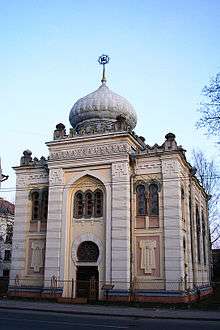
The local Karaim communities still exist in Lithuania (where they live mostly in Panevėžys and Trakai regions) and Poland. The 1979 census in the USSR showed 3,300 Karaim. Lithuanian Karaim Culture Community was founded in 1988.
According to the Lithuanian Karaim website the Statistics Department of Lithuania carried out an ethno-statistic research entitled "Karaim in Lithuania" in 1997. It was decided to question all adult Karaim and mixed families, where one of the members is a Karaim. During the survey, for the beginning of 1997, there were 257 people of Karaim nationality, 32 of whom were children under 16.
Religion
Until the 20th century, Karaism was the only religion of the Karaim,[37] During the Russian Civil War a significant number of Karaim emigrated to Yugoslavia, Czechoslovakia, Poland and Hungary and then France and Germany.[38][39] Most of them converted to Christianity. The Karaim's modern national movement philanthropist M.S. Sarach was one of them.[40]
The Crimean Karaites' emancipation in the Russian Empire caused cultural assimilation followed by secularization. This process continued in the USSR when most of the kenesas were closed.[41]
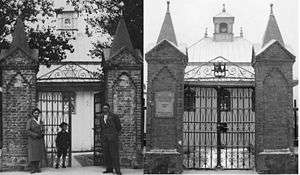
In 1928 secular Karaim philologist Seraya Shapshal was elected as Hacham of Polish and Lithuanian Karaim. Being a strong adopter of Russian orientalist V. Grigorjev's theory about the origin of the Crimean Karaites Khazarian, Shapshal developed the Karaim's religion and historical dejudaization doctrine[44]
In the mid 1930s, he began to create a theory describing the Altai-Turkic origin of the Karaim and the pagan roots of Karaite religious teaching (worship of sacred oaks, polytheism, led by the god Tengri, the Sacrifice). Shapshal's doctrine is still a topic of critical research and public debate.
He made a number of other changes aimed at the Karaim's Turkification and at erasing the Karaite Jewish elements of their culture and language.[45][46] He issued an order canceling the teaching of Hebrew in Karaite schools and replaced the name of the Jewish holidays and the months of the Turkic-speaking (see the table below).
According to Shapshal, Crimean Karaites were pagans who adopted the law of Moses, but continued to adhere to their ancient Turkic beliefs. In addition, he claimed that the Karaites had revered Jesus and Mohammed as prophets for centuries. In the Post-Soviet period, Shapshal's theory was further developed in modern Karaylar publications[47](e.g. "Crimean Karaites legends") and was officially adopted by the Crimean Karaim Association "Krymkaraylar" (Ассоциация крымских караимов “Крымкарайлар”) as the only correct view of the Karaim's past and the present in 2000.[48]
Evolution of Crimean Karaite holiday names in the 20th century
| Traditional Hebrew name (1915)[49][50]!!Secondary name | Modern Turkic name[51] | Turkic name translated to English.[52][53] | |
|---|---|---|---|
| Pesach | Hag ha-Machot (Unleavened bread festival) | Tymbyl Chydžy | Unleavened bread («Tymbyl») festival |
| Omer | Sefira (Counting of the Omer) | ||
| San Bašy | Counting Beginning | ||
| Jarty San | Counting Middle | ||
| Shavuot | Hag Shavuot (Feast of Weeks) | Aftalar Chydzy | Feast of Weeks |
| The 9th of Tammuz Fast | Chom Hareviyi (4th month fast) | Burunhu Oruč | First Fast |
| The 7th of Av Fast | Chom Hahamishi (5th month fast) | Ortančy Oruč | Middle Fast |
| The 10th of Av Fast" | Yom hа-Churban – The Destruction Day (of the Solomon's Temple). The other name: "Nedava"(offering) | Kurban | Sacrifice |
| Rosh HaShana | Yom Teru'ah (The blowing of horns day) | Byrhy Kiuniu | Horns Day |
| Yom Kippur | literally "The Day of Atonement" | Bošatlych Kiuniu | The Day of Atonement |
| Fast of Gedalia | Chom Hashviyi (7th month fast) | Omitted | |
| Sukkot | literally "Tabernacles". The other name: "Hag Ha Asif" ("Harvest festival") | Alačych Chydzy or Oraq Toyu | Tabernacles festival or Harvest festival |
| Tenth of Tevet fast | Chom Haasiri ((10th month fast)) | Oruč | Fast |
| Purim | "Lots". | Kynyš | Three-cornered shaped sweet filled-pocket cookie.[54] |
| ---------------------------- | Was not considered as Holiday | Jyl Bašy | The beginning of the Year |
Genetics
Leon Kull and Kevin Alan Brook led the first scientific study of Crimean Karaites using genetic testing of both Y chromosomal DNA and mitochondrial DNA and the results showed that Crimean Karaites are indeed partially of Middle Eastern origin and related to the descendants of rabbinic Jews.[55][56]
Culture
Language
Karaim is a Kypchak Turkic language being closely related to Crimean Tatar, Armeno-Kipchak etc. Among the many different influences exerted on Karaim, those of Arabic, Hebrew, and Persian were the first to change the outlook of the Karaim lexicon. Later, due to considerable Polish, Russian, and Ukrainian influence, many Slavic and Baltic words entered the language of Polish, Lithuanian, Ukrainian, and Russian Karaim. Hebrew remained in use for liturgical purposes. Following the Ottoman occupation of Crimea, Turkish was used for business and government purposes among Karaim living on the Crimean peninsula. Three different dialects developed: the Trakai dialect, used in Trakai and Vilnius (Lithuania), the Lutsk or Halych dialect spoken in Lutsk (until World War II), and Halych, and the Crimean dialect. The last forms the Eastern group, while Trakai and Halych Karaim belong to the Western group. Currently only small minority of Karaim can speak Karaim Language (72 Crimean dialect speakers,[1] 118 Trakai dialect speakers, and about 20 Halych dialect speakers)
Cuisine

The most famous Crimean Karaite food is Kybyn (Russian:Кибина pl. Кибины, Karaim: kybyn pl. kybynlar, Lithuanian: Kibinai). Kybynlar are half moon shaped pies of leavened dough with a stuffing of chopped beef or mutton, baked in dutch oven or baking sheet. Other meals common for Crimean Karaites and Tatars are Chiburekki, Pelmeni, Shishlik (These are most often made from mutton).[57]
Ceremony dishes, cooked for religious holidays and weddings are:
- Tymbyl is Pesach round cakes flat of unleavened[58] dough, knead with cream and butter or butter and eggs, reflected in modern name of this festival (Tymbyl Chydžy[59]),
- Qatlama is Shavuot (Aftalar Chydžy[59]) cottage cheese pie, which seven layers symbolizing seven weeks, past after Pesach, four layers of yeast dough, three – of pot cheese,
- Wedding pies are Kiyovliuk (on the part of the groom) and Kelin'lik (on the part of the bride).
See also
References
- 1 2 1,196 Karaites in the Ukraine as a whole (including the Crimea) Распределение населения по национальности и родному языку УКРАИНА Distribution of the population by nationality and mother tongue, Ukraine (Russian language version)
- ↑ Population in Autonomous Republic of the Crimea = 671, population in Sevastopol city council area = 44. 671+44 = 715. Распределение населения по национальности и родному языку, Автономная Республика Крым (Distribution of the population by nationality and mother tongue, Autonomous Republic of the Crimea)
Распределение населения по национальности и родному языку, Г.Севастополь (горсовет) (Distribution of the population by nationality and mother tongue, Sevastopol city council) - ↑ Ludność. Stan i struktura demograficzno-społeczna.Narodowy Spis Powszechny Ludności i Mieszkań 2011.
- ↑ "Gyventojai pagal tautybę, gimtąją kalbą ir tikybą" (PDF). Statistics Lithuania. Retrieved January 9, 2015.
- ↑ Russian Census 2010: Population by ethnicity Archived April 24, 2012, at the Wayback Machine. (Russian)
- ↑ Blady 113–130.
- ↑ Golden 2007a, p. 9
- ↑ Brook 2006 p. 110–111, 231.
- ↑ Erdal, Marcel (1999). "The Khazar Language". In: Golden et al., 1999:75–107
- ↑ «...After the days of Bulan there arose one of his descendants, a king Obadiah by name, who reorganized the kingdom and established the Jewish religion properly and correctly. He built synagogues and yeshiva|yeshivot, brought in Jewish scholars, and rewarded them with gold and silver. … They explained to him the Bible, Mishnah, Talmud and the order of divine services. The King was a man who revered and loved the Torah. He was one of the true servants of God. May the Divine Spirit give him rest!…» Khazar_Correspondence original text
- ↑ A. Harkavy, Altjudische Denkmaler aus der Krim, mitgetheilt von Abraham Firkowitsch, SPb., 1876.
- ↑ Miller ___.
- ↑ Vékony, Gábor (2004): A székely rovásírás emlékei, kapcsolatai, története [The Relics, Relations and the History of the Szekely Rovas Script]. Publisher: Nap Kiadó, Budapest. ISBN 963-9402-45-1
- ↑ Vékony, Gábor (1997): Szkíthiától Hungáriáig: válogatott tanulmányok. [From Scythia to Hungary: Selected Studies] Szombathely: Életünk Szerk. Magyar Írók Szövetsége. Nyugat-magyarországi Csoport. Ser.: Életünk könyvek, p. 110
- ↑
- «…ובשנת 1218 תתקע"ח לאלף החמשי וויטולט דוכוס הגדול של ליטא ערך מלחמה על הטטארים והשיג באי קרים ונלחם וישב שבי ויקח עמו מקירים 483 משפחות קראים ויוליכם לליטא ויצו לבנות להם עיר ויקרא אותה טראק החדשה ויתן להם כתב חרות ושדות ואדמה ויושיבם בעיר ההיא 330 משפחות...…»(
- 1 2 "Karaites of Crimea: History and Present-Day Situation in Community". Retrieved 14 April 2016.
- ↑ Nosonovsky, M.; Shabarovsky, V. (2005). "Караимская община XVI-XVIII веков в Деражном на Волыни". Vestnik EUM. 9: 31–52.
- ↑ Шабаровський, В. В (Shabarovsky, V.V.) (2013). Караїми на Волині (Karaites in Volhynia, in Ukrainian). Lutsk: Tverdynya.
- ↑ Shapira, Dan; Lasker, Daniel, J. (2011). Eastern European Karaites in the Last Generations. Jerusalem: Ben-Zvi Institute and the Center for the Study of Polish Jewry and its Culture.
- ↑ Jews and Heretics in Catholic Poland – A Beleaguered Church in the Post-Reformation Era – by Magda Teter
- ↑ «He-Avar» («Хе-Авар») Magazine, Petrograd, № 1, 1918
- ↑ Jacob Mann, "Karaica", Texts and Studies in Jewish History and Literature, no. 11, Philadelphia, 1935; Jurgita Šiaučiūnaitė – Verbickienė, Žydai Lietuvos Didžiosios Kunigaikštystės visuomenėje: sambūvio aspektai, Vilnius, 2009; Idem, Ką rado Trakuose Žiliberas de Lanua, arba kas yra Trakų žydai, in Lietuvos istorijos studijos, no. 7, 1999.
- ↑ Кизилов М. Ильяш Караимович и Тимофей Хмельницкий: кровная месть, которой не было, (М. Kizilov. Ilyash Karaimovich and Timofey Khmelnitsky: the blood feud that never took place) Institute of Oriental Studies of the Russian Academy of Sciences in publication Фальсификация исторических источников и конструирование этнократических мифов.«Hачиная приблизительно с межвоенного периода и вплоть до наших дней, караимские националисты стараются представить мирное караимское население Восточной Европы в роли «неустрашимых и храбрых воителей» , что едва ли одобрили их богобоязненные исторические предки, которые были преимущественно торговцами и ремесленниками».
- ↑ "Universitas Helsingiensis". Retrieved 14 April 2016.
- ↑ Древние привилегии литовско-волынских караимов, извлеченные из актов замка Луцкого 1791 г«Но вникнув в смысл привилегии Витольда замечаем, что в древние времена тамошние Караимы более всего занимались заимодавством; да, и по сие время зажиточные люди этого общества не оставляют этого прибыльного промысла; и отдавая свои капиталы в рост, в обеспечение их берут у своих должников в арендное содержание мельницы, корчмы, а чаще всего ссудят под заклад движимого имущества».
- ↑ Древние привилегии литовско-волынских караимов, извлеченные из актов замка Луцкого 1791 г«В следствие того они били челом его Королевской милости, что издавна еще при Великом Князе Витольде и при Сигизмунде и при отце нашем Короле Казимире его милости, жиды [Троцкие] (i.e Karaite Jews) никогда на войну не хаживали и не посылали».
- ↑ P. S. Pallas Bemerkungen auf einer Reise in die Südlichen Statthalterschaften des Russischen Reichs (1799–1801)
- ↑ Nosonovsky, M. (2011). "The Karaite Community in Derażne and its Leader Hazzan Joseph ben Yeshu'ah". Eastern European Karaites in the Last Generations: 17–35.
- ↑ Harkavy, Albert. "Altjudische Denkmaller aus der Krim mitgetheilt von Abraham Firkowitsch, 1839–1872." In Memoires de l’Academie Imperiale de St.-Peterboug, VIIe Serie, 24, 1877; reprinted Wiesbaden, 1969.
- ↑ Fisher, Alan W. (1978). The Crimean Tatars. Hoover Press. p. 264. ISBN 978-0-8179-6662-1. Retrieved 2009-11-08.
- ↑ YIVO archives, Berlin Collection, Occ E, 3, Box 100, letter dated January 5, 1939.
- ↑ Semi passim.
- ↑ Blady 125–126.
- ↑ Green passim.
- ↑ The Karaite Encyclopedia by Nathan Schur (Frankfurt, 1995)
- ↑ Ahiezer, G. and Shapira, D. 2001.'Karaites in Lithuania and in Volhynia-Galicia until the Eighteenth Century' [Hebrew]. Peamin 89: 19–60
- ↑ Катехизис, основы Караимского закона. Руководство по обучению Закону-Божию Караимского юношества. — СПб., 1890.
- ↑ Album «Archive of the Dmitri Penbeck’s family» – compiled by V. Penbek — Simferopol-Slippery Rock, 2004. — C. 24
- ↑ Кропотов В. С. Военные традиции крымских караимов — Симферополь, 2004. — C. 75
- ↑ Virtual Karaim Museum
- ↑ Mikhail Kizilov. "Karaites and Karaism: Recent Developments". paper presented at the CESNUR 2003 Conference, Vilnius, Lithuania. Retrieved 14 April 2016.
- ↑ "...its cupola was originally surmounted by a shield of David, but the removal of this emblem was ordered some ten years ago by the local hakham [i.e. Szapszał] as smacking too much of traditional Judaism. The offending symbol, however, still remains on the iron gate, from which it could hardly be removed without causing a conspicuous blemish...”Published in : ISRAEL COHEN, Vilna, Philadelphia 1943, pp. 463–464
- ↑ Seraphim, Peter Heinz. Das Judentum im Osteuropäischen Raum, 1938 "...126. Das Wappen der Karaimen am Eingang zu ihrer "Kenessa" in Troki bei Wilna..."
- ↑ Roman Freund «Karaites and Dejudaization» (Acta Universitas Stockholmiensis. 1991. – №30).
- ↑ М. Кизилов, «Новые материалы к биографии Шапшала»// Материалы девятой международной конференции по иудаике (2002), с. 255—273.
- ↑ E.g compare the Trakai kenassa gate in 1932 and today File:Trakai Kenesa.JPG
- ↑ A. Malgin. Евреи или тюрки. Новые элементы в идентичности караимов и крымчаков в современном Крыму [Jews or Turks. New elements in the identity of the Karaites and Krypchaks in modern Crimea] (2002)
- ↑ «Попытки приписать крымским караимам чуждые этнос и религию, смешение этнических крымских караимов с караимами по религии, искажение истории — оскорбляют национальные чувства и создают предпосылки для национальных и религиозных конфликтов.» («Attempts to attribute the Crimean Karaites alien ethnicity and religion, mixing ethnic Crimean Karaites with the Karaites on religion, the distortion of history – offend the national feelings and create the conditions for national and religious conflicts») Караи (крымские караимы). История, культура, святыни. — Симферополь, 2000.
- ↑ КАРАИМСКИЙ КАТИХИЗИС ВКРАТЦЕ/ Сост. М. Я. Фиркович. — Мелитополь:1915г( Karaite Catechism briefly/ M.J Firchovich. – Melitopol 1915 )
- ↑ THE BRIEF CATECHISM -THE INSTRUCTIONS for basic education of karaite children in the Law of God and the brief history of karaism //Y B. Shamash(Translation from Russian of КРАТКИЙ КАТИХИЗИС/ Сост. Я. Б. ШАМАШ)
- ↑ «Lithuanian Karaim Calendar»
- ↑ Караимско-русско-польский словарь / Н. А. Баскаков, А. Зайончковский, С. Ш. Шапшал, 1974,
- ↑ "Караимские праздники.". Retrieved 14 April 2016.
- ↑ "Народы России - Национальная кухня крымских караимов (караев)". Retrieved 14 April 2016.
- ↑ Kevin Alan Brook, Leon Kull, and Adam J. Levin, "The Genetic Signatures of East European Karaites," August 28, 2013,
- ↑ Kevin Alan Brook, "The Genetics of Crimean Karaites," Karadeniz Araştırmaları №42 (Summer 2014): pp. 69–84, pdf
- ↑ Virtual Karaim Museum
- ↑ «Lietuvos karaimai: Religija: Šventės».»
- 1 2 "Календарь". Retrieved 14 April 2016.
Bibliography
- Ben-Tzvi, Yitzhak. The Exiled and the Redeemed. Philadelphia: Jewish Publication Society, 1957.
- Blady, Ken. Jewish Communities in Exotic Places. Northvale, N.J.: Jason Aronson Inc., 2000. pp. 115–130.
- Brook, Kevin Alan. The Jews of Khazaria. 2nd ed. Rowman & Littlefield Publishers, Inc, 2006.
- Friedman, Philip. "The Karaites under Nazi Rule". On the Tracks of Tyranny. London, 1960.
- Green, W.P. "Nazi Racial Policy Towards the Karaites", Soviet Jewish Affairs 8,2 (1978) pp. 36–44
- Golden, Peter B. (2007a). "Khazar Studies: Achievements and Perspectives". In Golden, Peter B.; Ben-Shammai,, Haggai; Róna-Tas, András. The World of the Khazars: New Perspectives. Handbook of Oriental Studies. 17. BRILL. pp. 7–57. ISBN 978-9-004-16042-2. Retrieved February 13, 2013.
- Karaite Judaism: Introduction to Karaite Studies. Edited by M. Polliack. Leiden: Brill Publishers, 2004, 657–708.
- Kizilov, Mikhail. Karaites Through the Travelers' Eyes: Ethnic History, Traditional Culture and Everyday Life of the Crimean Karaites According to the Descriptions of the Travelers. Qirqisani Center, 2003.
- Kizilov, Mikhail. "Faithful Unto Death: Language, Tradition, and the Disappearance of the East European Karaite Communities," East European Jewish Affairs 36:1 (2006): 73–93.
- Krymskiye karaimy: istoricheskaya territoriya: etnokul'tura. Edited by V.S. Kropotov, V.Yu. Ormeli, A. Yu. Polkanova. Simferpol': Dolya, 2005
- Miller, Philip. Karaite Separatism in 19th Century Russia. HUC Press, 1993.
- Semi, Emanuela T. "The Image of the Karaites in Nazi and Vichy France Documents," Jewish Journal of Sociology 33:2 (December 1990). pp. 81–94.
- Shapira, Dan. "Remarks on Avraham Firkowicz and the Hebrew Mejelis 'Document'." Acta Orientalia Academiae Scientiarum Hungaricae 59:2 (2006): 131–180.
- Shapira, Dan. "A Jewish Pan-Turkist: Seraya Szapszał (Şapşaloğlu) and His Work 'Qırım Qaray Türkleri'," Acta Orientalia Academiae Scientiarum Hungaricae 58:4 (2005): 349–380.
- Shapira, Dan. Avraham Firkowicz in Istanbul (1830–1832). Paving the Way for Turkic Nationalism. Ankara: KaraM, 2003.
- Shapshal, S. M.: Karaimy SSSR v otnoshenii etnicheskom: karaimy na sluzhbe u krymskich chanov. Simferopol', 2004
- Zajączkowski, Ananiasz. Karaims in Poland: History, Language, Folklore, Science. Panistwowe Wydawn, 1961.
External links
- Official site of the Crimean Karaites
- http://www.cesnur.org/2003/vil2003_kizilov.htm
- http://www.berkovich-zametki.com/Nomer35/MN55.htm
- http://www.berkovich-zametki.com/Nomer41/Kizilov1.htm
- Karaim Website
- Signs of New Life in Karaim Communities
- Karaites in the Holocaust
- web site of Lithuanian Karaims
- KARAITE LIBRARY online
- The origin of the (European) Karaites in the books and texts of Karaite hakhams
